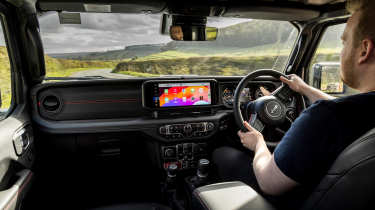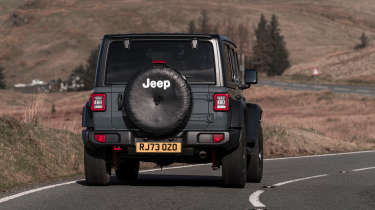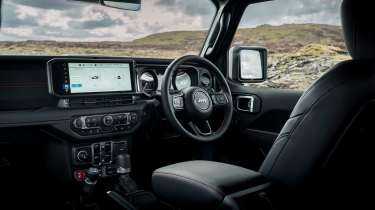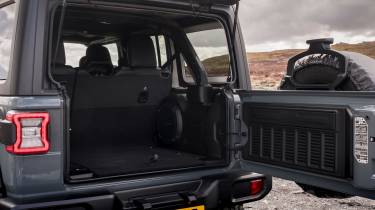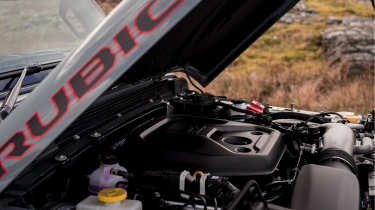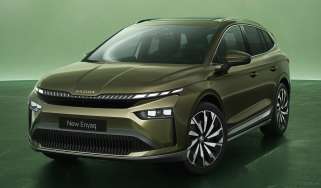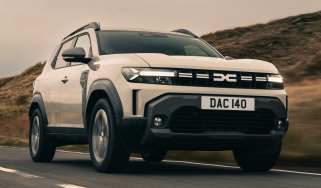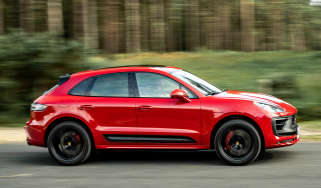Jeep Wrangler review – amazing off-roader with some compromises
“The Jeep Wrangler combines iconic looks with excellent off-road ability but it’s expensive to buy and own, while also being a bit impractical”
Pros
- Off-road prowess
- Updated interior
- Flexible roof options
Cons
- Too expensive
- High running costs
- Poor refinement
Verdict – is the Jeep Wrangler a good car?
The Jeep Wrangler isn’t an SUV most buyers will be cross-shopping with other models, because this hardcore 4x4 is to off-roading what a Porsche 911 is to performance driving. It excels over rough terrain, but there are compromises to refinement, handling and safety tech when you rejoin the tarmac. It’s even more extreme in this regard than rivals like the Land Rover Defender and Toyota Land Cruiser, so while the Wrangler won’t be for everyone, it does hold plenty of appeal for hardcore off-road enthusiasts with deep pockets.
Jeep Wrangler models, specs and alternatives
If you judged the latest Jeep Wrangler SUV on looks alone, you might wonder what all the fuss was about. But delve deeper and this fifth generation was the most radical overhaul of the iconic model for years. There were new engines, the interior was updated and there were new roof designs along with more safety equipment. It was further updated again for 2024, ushering in a much better infotainment setup amongst other improvements.
Underneath, the Wrangler is still a rugged off-roader that prioritises approach angles over fuel economy. Until the reimagined Land Rover Defender arrived, the Wrangler was virtually in a class of one. If you simply need a rugged SUV that can head off road from time to time, it’s also hard to ignore the Land Rover Discovery Sport, while the Toyota Land Cruiser is also famed for its ability to cross deserts without fuss, and has just been relaunched for the first time in years. Alternatively, a prospective Wrangler buyer may even consider a stylish pickup like the Volkswagen Amarok, or – if budget isn’t an issue – the Mercedes G-Class. Not that the Wrangler itself is exactly an affordable pick, with a starting price of more than £60k that can feel rather exorbitant at times.
More reviews
The Wrangler’s exterior design is such a trademark that the American brand doesn’t even put a badge on the front, simply relying on its upright seven-slot grille, round headlights, flat wheel arches and exposed hinges to instantly tell people what they’re looking at. Those design touches are lifted from the original Willy's Jeep. There are some tweaks, if you look closely; the headlights are now LEDs in Sahara and Rubicon models, while the wheel arches are slightly more aerodynamic and feature integrated daytime running lights. The windscreen is also tilted slightly further back to reduce drag and now includes a ‘stealth’ antenna, but don’t worry – it can still be folded down for a really unique driving experience. You can also take the doors off and choose what kind of removable roof you’d like, even if this is more suited to the American desert than Amersham.
Interior changes are less subtle because despite the retro dashboard design, Jeep’s latest 12.3-inch infotainment system arrived in 2024 with improved connectivity, navigation and lots of ways to stay entertained including Apple CarPlay and Android Auto connectivity. However, the interior doesn't feel as well-finished as the Defender's, and the transmission tunnel makes it feel less spacious than you might expect.
At launch, UK buyers could choose from either a two-door or four-door bodystyle and Sport, Sahara, Overland or Rubicon trim levels. However, the entry-level Sport has now been phased out. The engine choice used to be between a petrol or diesel, with the first getting you a 2.0-litre turbocharged engine with 268bhp and the latter a 2.2-litre with 197bhp; both with an eight-speed automatic gearbox as the sole option. Now, however, the diesel option has been dropped from the range altogether, which makes life simpler still. The engine might be smaller than those in the previous model, but running costs sadly haven’t shrunk as much as buyers might have hoped.
The way the Wrangler drives on the road blurs the lines between SUVs, old-school 4x4s and pickups, but it is better on UK roads than we expected. Although there's plenty of road noise in the Rubicon – courtesy of its knobbly mud tyres – it’s still competent and reasonably civilised on the tarmac, even if rivals like Defender feel more car-like. The steering, ride and brakes have all been improved on this new model, making it more like a regular SUV than ever before, but it still makes much more sense off-road, where the Wrangler is virtually unstoppable. It’s the number one choice for off-road enthusiasts around the globe for a reason, with an uncanny ability to haul itself up slopes, over rocks and through mud and water.
MPG, running costs & CO2
Both the now defunct diesel and the current petrol engine were ‘downsized’ for the latest Wrangler, with the old 3.6-litre V6 petrol making way for a 2.0-litre four-cylinder unit that’s designed and made in Italy rather than the US.
In almost every regard, the Wrangler prioritises its iconic design and ruggedness above efficiency and, as a result, fuel economy is poor, with the Rubicon averaging 24.8mpg. Even with the arrival of the Land Rover Defender, the Wrangler is in a small class as far as direct rivals go. Choose a Land Rover Discovery Sport and you might not be able to go quite as far off-road, but it’ll be far cheaper to run, while a Toyota Land Cruiser delivers similar fuel economy to the wrangler, albeit using a 2.8-litre diesel engine.
If you’re buying used, the Wrangler’s formerly-available 2.2-litre four-cylinder diesel is fitted in a variety of fairly economical Alfa Romeos, Fiats and Jeeps, but here it can only manage around 30mpg, while emitting over 240g/km of CO2, largely because of the Wrangler's bluff aerodynamics. This places it firmly in the top Benefit-in-Kind (BiK) band for anyone who might fancy running a Wrangler as a company car. The Defender returns up to 33.8mpg even with a larger 3.0-litre diesel engine, and it comes with the option of a plug-in hybrid powertrain.
Every Wrangler costs the standard rate in annual VED (road tax) and because it costs more than £40,000 (including options), it incurs a hefty surcharge in years two to six, for a total of over £500 a year during this period.
Like all Jeeps, the Wrangler comes with a three-year warranty and seven years of cover against corrosion, which is similar to that of the Land Rover, but quite a bit shorter than what’s offered by rivals such as Toyota.
Engines, drive & performance
There’s been a huge increase in SUV sales in recent years thanks to vastly reduced running costs, improved handling and impressive refinement as high-riding vehicles have become increasingly car-like. But the Wrangler can trace its roots back to the Second World War, and has clung on to its hero-like off-roading status. As a result, it’s now one of a dying breed of 4x4s that prioritise strength and go-anywhere ability above all else.
The car’s better to drive on the road than before, especially in Sahara trim, with more precise steering, better brakes and a slightly less bouncy ride. However, it's still not as polished as the Land Rover Defender or the latest Land Cruiser, with their more modern designs, and you'll notice a huge difference if you're stepping up from a road-biased SUV. The Wrangler feels like an off-roader that’s also okay to drive on the road, rather than the other way around.
Underneath there’s a ladder-frame chassis and tough axles more akin to those in a pickup than an SUV. And in the range-topping Rubicon model these are upgraded further with locking differentials to meter out traction and a low-range gearbox designed for crawling over rocks and up seemingly impossible slopes. It’s simply brilliant at traversing, climbing and wading through rivers.
Buy new and your only option is the 2.0-litre petrol engine, which is smooth and powerful but also only comes with an automatic gearbox. In the two-door Sahara, acceleration from 0-62mph takes 7.3 seconds and in the four-door it’s 7.6 seconds. It sounds rather coarse, but isn’t short of power for surging up steep slopes and towing heavy loads. The eight-speed automatic gearbox is fairly responsive, too, but the Wrangler isn’t an SUV you want to drive too quickly – its steering requires lots of input and there’s quite a bit of body lean.
If you’re interested in an older diesel version, the engine is far quieter than you might expect, only emitting a boom if you really floor the accelerator. Perhaps surprisingly given the Wrangler’s fan base, there was no manual version offered but it also came with an eight-speed automatic gearbox, which works well enough, providing low gears for off-roading and a more relaxed experience on the motorway. In some situations it feels more like a CVT automatic because revs can quickly rise as you accelerate. It has 197bhp and the four-door takes around 10 seconds to get from 0-62mph, before topping out at just 99mph.
Interior & comfort
All things considered, it’s inside where the Wrangler has improved most thanks to a complete redesign for this generation. The dashboard still looks traditional thanks to its straight lines and chunky buttons, there’s an upright driving position, and the steering wheel now adjusts for reach and rake to aid comfort. Materials are more expensive and tactile, but still look rugged enough to cope with a coating of dust.
There’s also a touchscreen that was upgraded to a new 12.3-inch setup for 2024, instead of the largest 8.4-inch screen from before. It has connections for your smartphone and sat-nav, along with compatibility for Apple CarPlay and Android Auto, impressive resolution and quick responses. The Wrangler’s designers have clearly thought about what fans of the vehicle want to see, including auxiliary plugs at the bottom of the fascia to make adding accessories, such as extra lights easier. It falls short of offering the same level of quality as the Defender, however, which feels more upmarket and minimalist. Despite the bigger screen, the Wrangler’s centre console is still festooned with controls, along with levers for the transmission.
One of the Jeep’s most unique quirks is the option to take off its doors and fold down its windscreen, features that link right back to its ancestors and tie in with the outdoor lifestyle Jeep expects its owners to associate with the car. Every Wrangler has its own toolkit, with just four bolts that need to be removed to drop the windscreen. Unclipping the doors is simple thanks to handles under the armrests, and there’s a spot under the boot floor to keep the door pins, bolts and straps safe.
Three types of roof are also offered, called ‘Sky One Touch’, ‘Zipperless Premium Sunrider’ and ‘Freedom’. In order, these are a powered soft-top, a manual soft version that requires you to remove sliding panels in and out of runners and a modular hard-top that’s also easily removed.
Practicality & boot space
While both a two-door and four-door Wrangler are offered in some markets, just the four-door is available in the UK in spring 2024. It makes a big difference to the length of the vehicle, adding 55cm between its front and rear bumpers. We’ve tried the two-door previously, and for such a big vehicle there’s less room than you might think inside. Even in the four-door, the large transmission tunnel makes the Wrangler feel narrower than you may expect, with just enough width for two adults up front and very little space to rest your left leg when it isn’t on one of the pedals.
We can see why the two-door is a niche proposition because while hardcore fans may favour it for its off-road prowess, anyone used to a more conventional SUV might be surprised to learn it only has a meagre 197-litre boot behind the rear seats – smaller than that of a Volkswagen up! city car. If you treat it more like a two-seater, things improve, because with the back seats flipped forward this increases to 587 litres. The Toyota Land Cruiser has a 620-litre boot with five seats in place.
The four-door Wrangler’s extra length means there’s a 533-litre boot, growing to 1,044 litres with the back seats folded down, making it much more family-friendly. The spare wheel still hangs off the tailgate, but it’s now positioned 300mm lower down to improve rear visibility. It’s worth bearing in mind this can make it quite heavy to open, though, and it can be trickier to access than a hatchback in a tight car park. Speaking of visibility, this is one area where the flat bonnet and flared fenders are a disadvantage both on or off-road, because they make it quite hard to see directly in front of the Wrangler, and it lacks the Defender’s nifty ‘See-Through’ bonnet camera technology.
Reliability & safety
The Wrangler’s evolution is perhaps best described as ‘steady’, and this path has been chosen to keep it as rugged and dependable as possible. After all, it’s not much good breaking down when you’re so far off the beaten track that no breakdown truck could ever reach you.
While Jeep didn’t feature in our 2023 Driver Power customer service satisfaction survey, parent company Fiat came a disappointing 31st out of 32 carmakers. This was despite a low 12% of owners reporting a fault within the first year, which flew in the face of bottom-table results for reliability, interiors, practicality and safety.
Safety technology has been rather lacking in the past, but the latest version does better, even if it’s still off the pace of most rivals. New features include blind-spot warnings and warnings for traffic as you reverse, along with a system to help prevent the Wrangler rolling over. It was further bolstered in 2024 with extra side airbags, lane departure warnings, traffic-sign recognition and a system to alert the driver if they could be getting drowsy.
In terms of safety ratings, however, the Wrangler remains some way behind its competitors. When Euro NCAP published its safety ratings, the Wrangler received a single star, and this was only thanks to the seatbelt reminder and a driver-set speed limiter feature. It’s not yet known if the 2024 updates will prompt a re-test, but it’s unlikely given the Wrangler’s small volume of sales in Europe.


